Speech Australian Financial Markets

Ric Battellino
Assistant Governor (Financial Markets)
Address to Conference:
‘The Future of the Australian Debt Market Beyond 2000’
Canberra –
This conference is very timely because the bond market in Australia is moving through some fundamental change at present. Managing this change will produce challenges for the authorities and the market.
Change is, of course, nothing new for Australian markets. Experience shows that they have had a great capacity to adapt and grow over the past twenty years or so of financial deregulation. The changes currently facing the Australian debt markets should therefore be seen not only as challenges but also as opportunities.
I have been asked today to talk about the general topic of Australian Financial Markets. I thought it might be useful to set the scene by making some broad observations about our markets, sketching trends and exploring briefly the underlying influences on them. I will then talk more specifically about some of the data the Reserve Bank has been collecting on the corporate bond market.
Australian Financial Markets
Australian financial markets have all the hallmarks of a modern financial system, with highly developed markets across the whole range of financial products – money and banking, bonds, equities, foreign exchange and derivatives. Australian markets are not large by standards of the global leaders in New York and London, but nor are they inconsequential (Table 1).
| Outstandings | Average Daily Turnover(b) | Average Annual Growth in Turnover 1995-1998 | |
|---|---|---|---|
| ($ billion) | ($ billion) | (Per cent) | |
| Fixed-Interest | |||
| Money Market Securities | 196 | 6.3 | 18 |
| Bonds | 185 | 4.5 | −10 |
| Repurchase Agreements | .. | 12.3 | 27 |
| Derivatives | 37 | 10 | |
| Equities | |||
| Physical | 568(c) | 1.0 | 27 |
| Derivatives | .. | 1.1 | 24 |
| Foreign Exchange(d) | .. | 76 | 16 |
|
(a) As at June 1999. (b) Derived from 1998 Australian Financial Markets Report, AFMA. (c) Market capitalisation of listed domestic equities. (d) Central Bank Survey of Foreign Exchange and Derivatives Market Activity, 1998 BIS. |
|||
As in most countries, the foreign exchange market in Australia is the largest market sector, with turnover of about $76 billion a day, a little over half of which involves the Australian dollar. The Australian foreign exchange market is the 9th largest in the world and the Australian dollar is the seventh most actively traded currency in the world, marginally behind the Canadian dollar (Table 2). To put this in perspective, in terms of overall economic size, Australia ranks 14th in the world, so trading in the Australian dollar is well ahead of where one would expect it to be given the size of the economy. Its relatively high global position reflects the special place the Australian dollar holds in portfolios of international funds managers because of its relation to commodity prices, offering a degree of diversification from other currencies.
| Gross Domestic Product(a) | Foreign Exchange Turnover(b) | Equity Market Turnover | Fixed Interest Market Turnover | Institutional Investment(f) |
|||
|---|---|---|---|---|---|---|---|
| By market | By currency | Physical market | Futures market(c) | Physical market(d) | Futures market(e) | ||
| USA | UK | US dollar | USA | USA | USA | USA | USA |
| Japan | USA | Euro | Taiwan | Germany | Japan | UK | Japan |
| Germany | Japan | Japanese yen | Germany | Japan | Germany | Germany | UK |
| France | Singapore | Pound sterling | UK | Italy | Italy | Japan | France |
| UK | Germany | Swiss franc | Japan | France | France | Singapore | Germany |
| Italy | Switzerland | Can. dollar | Switzerland | UK | UK | Australia | Netherlands |
| China | Hong Kong | Aust. dollar | Hong Kong | Spain | Canada | Canada | |
| Brazil | France | Spain | Korea | Netherlands | Italy | ||
| Canada | Australia | France | Hong Kong | Belgium | Switzerland | ||
| Spain | Canada | Singapore | Denmark | Luxembourg | |||
| Mexico | Netherlands | Switzerland | Spain | Australia | |||
| Netherlands | Italy | Australia | Switzerland | ||||
| India | Australia | Sweden | |||||
| Australia | Australia | ||||||
|
(a) Nominal GDP, 1998. Source: ‘World Financial Markets’, JP Morgan, July 1999.
(b) Source: Central Bank Survey of Foreign Exchange and Derivatives Market Activity, 1998, BIS. (c) Sharemarket index futures. Source: Various exchanges, Futures and OTC World magazine. (d) Bond market outstanding (total publicly listed). Source: ‘How Big is the World Bond Market?’, Salomon Smith Barney, July 1999. (e) Includes money market futures contracts. Source: Various exchanges, Futures and OTC World magazine. (f) Assets under management of institutional investors. Source: Institutional Investors 1998, OECD. |
|||||||
The standing of the Australian dollar as a world currency is recognised by its inclusion in the first wave of currencies (along with the US Dollar, euro, yen, Swiss franc, pound and Canadian dollar) in the Continuous Linked Settlement System for foreign exchange settlement that is due to come into operation in 12–18 months' time.
Other domestic markets are much smaller than the foreign exchange market, and do not generally rank quite as high on the international scale: markets in physical instruments typically rank just outside the global top 10 in terms of turnover, though some related derivative markets are among the 10 largest. For the most part, these positions are in the ballpark of where they might be expected given the ranking of the Australian economy on a world scale.
If growth in a market is a measure of its health, Australian markets are in reasonable shape. With the exception of the market for government securities, the major Australian markets have all grown at double-digit rates in recent years.
Statistics themselves are not always a reliable guide to the quality of markets. On some measures, and in some products, Australian markets are smaller than others in the Asian region, but nonetheless, at the height of the Asian and Russian crises, overseas banks chose to operate in Australia to cover positions established in Asian markets because liquidity in those markets was inadequate at the time.
The fact that Australia has well-developed markets in a wide range of products suggests well-balanced development of the Australian financial system. This partly reflects the fact that the critical markets in Australia are based on financing the local economy, in the domestic currency. This contrasts with some other centres in Asia which are, in large part, offshore centres. For example, in Singapore and Hong Kong, trading involving the domestic currency accounts for only 13 per cent and 24 per cent, respectively, of foreign exchange turnover.
Many factors have contributed to the development of Australia's financial markets. Particularly important has been the adoption of market-based policies over many years. The deregulation of the financial system in the 1980s, and the floating of the exchange rate and abolition of exchange controls in 1983, were pivotal.
Also, the Bank has always been keen to ensure that the infrastructure supporting markets is at best international practice:
- Australia was early to achieve best practice in the prudential sphere, adopting the Basel capital framework for banks in the late 1980s.
- In the case of payments and settlements systems, Austraclear pioneered a big improvement in the efficiency of settlements in the mid 1980s. This was followed by the Bank's RITS system, which introduced delivery-versus-payment, and then the ASX's CHESS system for equities. More recently, these electronic settlement systems have been inter-linked through the RTGS system to provide a very efficient payments and settlements infrastructure. Australia's RTGS system is among the most advanced in the world because of the way it closely links to securities settlements, giving it a very high coverage.
Healthy development of financial markets also requires a sound underlying monetary framework. The implementation of monetary policy in Australia is market-based, with a high degree of transparency in both the operational objective (expressed in terms of the cash rate target) and the ultimate objective (expressed as an inflation target).
Stability of the monetary policy framework – and of policy settings themselves – seems to have been a source of confidence for financial markets in Australia, helping them avoid the extreme market instability that characterised many countries over the past couple of years. This stability is perhaps best captured by the stability of the setting of monetary policy itself (Graph 1).
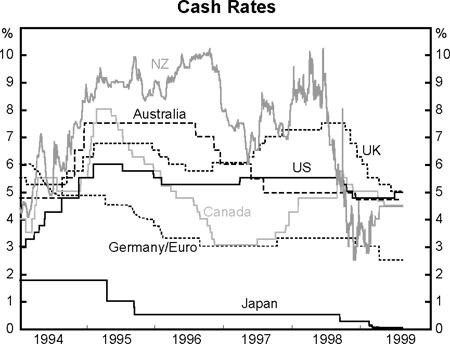
Australia's standing in world financial markets was reinforced recently when it was one of the "significant financial centres" invited to join the Financial Stability Forum, a group set up by G7 to monitor the international financial system. Australia is represented on this group through the Governor of the Reserve Bank.
Globalisation
A supportive regulatory framework, and confidence in policy, can provide a solid foundation for markets. But in markets such as ours which are so open, international forces are also a major influence on market developments. The impact of globalisation on Australian markets is evident in a number of ways: the high turnover of Australian dollars I referred to earlier, with 60 per cent of that turnover taking place internationally; more than half of turnover of foreign exchange in the Australian market is with a counterparty overseas; and about 40 per cent of Commonwealth Government securities outstanding is held overseas.
It can also be seen in the behaviour of financial prices themselves, which are very closely linked to international developments. The behaviour of the Australian dollar exchange rate is one example; since it was floated in the early 1980s, the path it has followed has been very similar to that of world commodity prices (Graph 2).
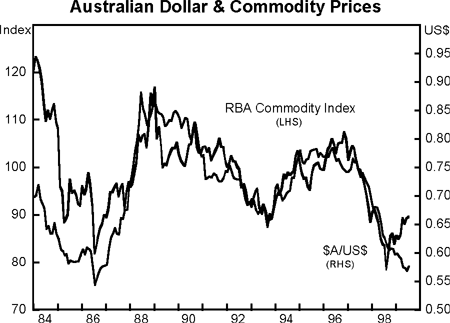
Strong international influences are also evident in the behaviour of fixed interest and equity markets. There is a high degree of correlation between markets in Australia and those overseas, particularly the US, with correlations tending to increase over recent years (Table 3).
| Bond Yields | Equity Prices | |||
|---|---|---|---|---|
| Daily Movements | Monthly Movements | Daily Movements | Monthly Movements | |
| Past 10 years | .47 | .68 | .49 | .55 |
| Past 3 years | .54 | .68 | .56 | .67 |
| Past year | .53 | .90 | .54 | .84 |
No doubt, there is a variety of forces working to produce such outcomes, but an important factor has been the degree of convergence in inflation outcomes. This has been particularly important in bringing about the sharp convergence of bond yields that we have seen around the world over the past few years (Graphs 3 and 4).
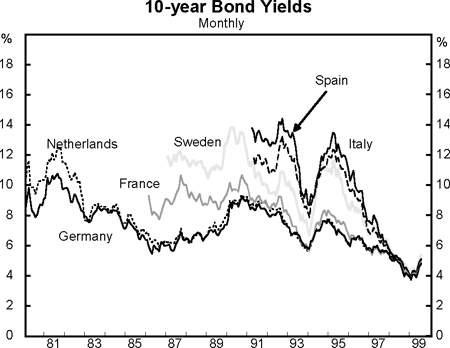
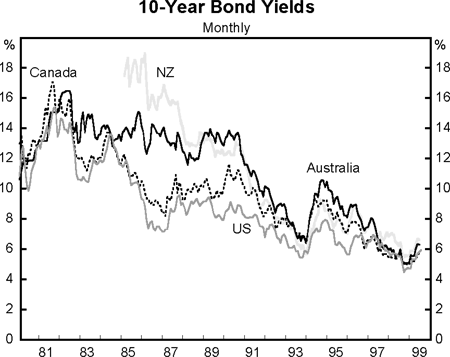
Bond yields in Australia have fallen from an average of about 14 per cent in the second half of the 1980s to an average of about 6 per cent over the past couple of years. The spread between Australian and US bond yields has contracted from nearly 450 basis points at the beginning of the 1990s to an average of about 25 basis points more recently. Also, the spread seems to have become more resilient to periods of stress in markets, with the widening of the spread during such times now much less pronounced than was the case in the past.
This convergence of yields has implications for the behaviour of investors: with bond yields in different countries tending to move together, investors have found it more difficult not only to diversify their portfolios but to find trading opportunities. As a result, investors seeking additional returns from fixed-interest portfolios have been prepared to accept greater credit risk than in the past. In a world of low yields, the incremental return from taking credit risk is more worthwhile than in the previous world of perennially double-digit yields. This has been a factor in the rapid growth recently in our corporate bond market – which I will say more about shortly.
Beyond its impact on market prices, globalisation also raises important questions about the development of financial markets. It is reshaping the international financial system in apparently contradictory ways. Saskia Sassen, in a recent article in Foreign Affairs[1], describes a ‘wave of consolidation’ in global financial markets at the same time as there is a ‘powerful trend of decentralisation’.
Consolidation is evident in the merger activity among financial institutions both across national boundaries and across earlier financial boundaries, such as those separating investment banking and insurance. Consolidation is also evident in location. Ultimate decisions about financing have become more highly concentrated in those centres where the global banks reside; this has tended to produce a concentration of deal-making talent in these centres. Thus, cities such as New York and London have become the hubs of the international financial system. These two centres, for example, now account for 50 per cent of world foreign exchange market turnover, up from 40 per cent a decade ago.
At the same time, however, new technologies in the telecommunication and information sectors are making it easier for institutions to co-ordinate regional activities and have tended to encourage decentralisation of some financing activities, particularly those where proximity to clients is an advantage.
It is hard to tell how these forces will shape the world financial system, particularly in as far as they affect the tier of financial centres lying below the global centres. Australia's market-based regulatory regime will work in its favour, but we cannot be complacent. Australia is a long way from the big population centres of the world, and therefore from the customers that ultimately drive financial activity. We are also at a disadvantage because we are not a capital exporting country, which has tended to be a characteristic of major financial centres. We will need to work hard if we are to maintain and promote our markets. The Bank therefore welcomes and strongly supports the recent initiatives of the Commonwealth Government to promote Australia as a centre for global financial services.
The Market for Non-government Bonds in Australia
I want to turn now to the market for non-government bonds. This market has been holding great promise for a decade or so, but until recently has generally disappointed expectations. That now seems to be changing.
The Bank has been collecting data on this market for some time, using various market sources and cross-checking with securities held in Austraclear, the main depository for private sector securities. Our collection covers fixed-interest as well as floating rate bonds, and includes private placements. The data are published in the Bank's Bulletin each month.
The Main Features of the Market
The figures show that this market has begun to grow strongly over the past year or so. New domestic issues of bonds by private borrowers have reached record levels in 1999 – an average of $2.3 billion a month, compared with an average of $1 billion a month in 1998 (Graph 5). So far in 1999, the amount of non-government bonds on issue has increased by 35 per cent, to $54 billion. Outstandings have increased by a factor of about 2 ½ since mid 1996 and are now larger than those for State government paper (Graph 6).
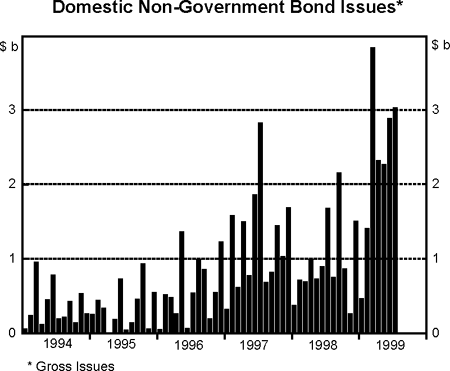
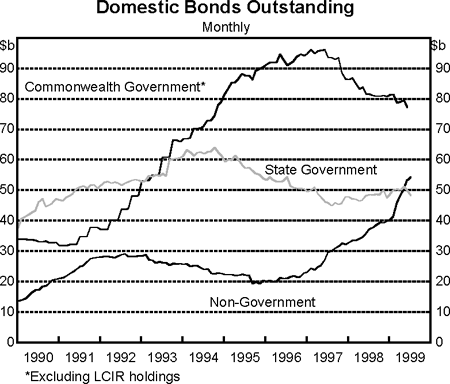
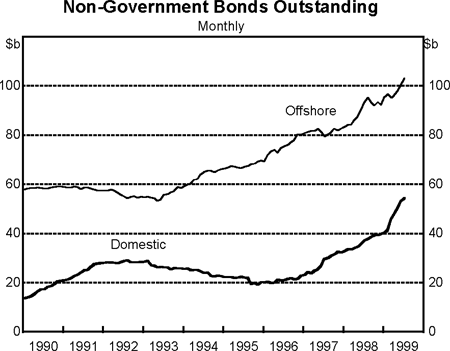
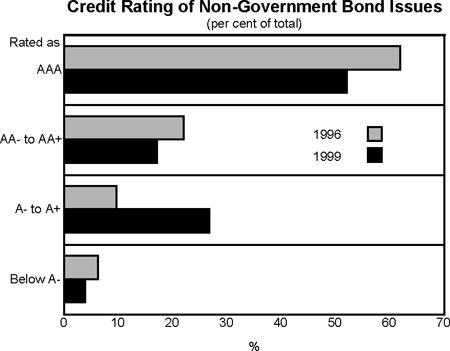
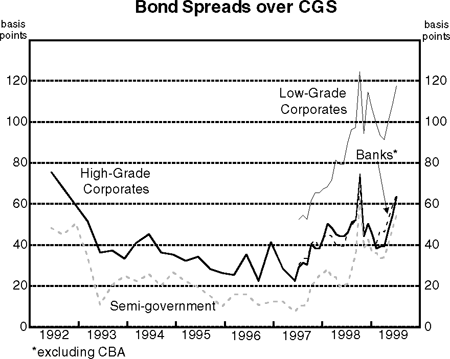
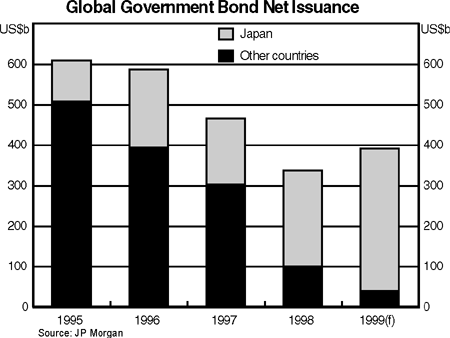
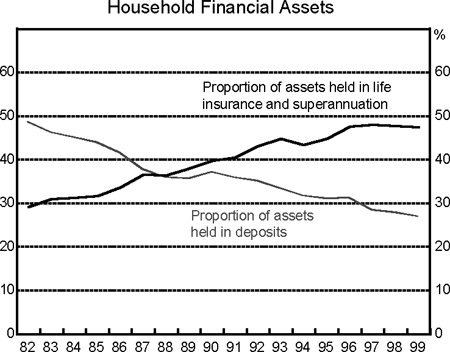
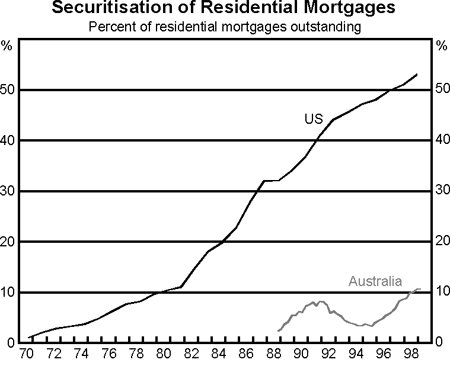
The major issuers in this market are asset-backed issuers (with $20 billion outstanding), followed by financial institutions ($17 billion), corporates ($11 billion) and non-residents ($7 billion). The value of bonds outstanding in each of these sectors is shown in Table 4. The main impetus to recent growth has come from bank issues, although there has also been a sizeable increase in issues by corporations. In the previous couple of years, growth had come mainly from asset-backed bonds.
| Dec 1995 | Dec 1998 | July 1999 | |
|---|---|---|---|
| Asset-backed | 8 | 18 | 20 |
| Banks and other financial institutions | 5 | 11 | 17 |
| Corporates | 4 | 7 | 11 |
| Non-residents | 2 | 4 | 7 |
| Total | 20 | 40 | 54 |
Traditionally, Australian corporates had issued into offshore markets. That now seems to be changing. Of the $50 billion increase in the past couple of years in total non-government bond outstandings (offshore plus local issuance), almost two-thirds has been within the local market (Graph 7). This represents a sharp reversal in the historical pattern.
The recent fast growth of the corporate market has been associated with a changing pattern in the credit ratings of issuers. In the past, the domestic market seemed accessible only to a few highly rated companies. Although bonds rated at AAA still dominate, the proportion of new issues of bonds rated A+ or below has increased from 15 per cent in 1996 to 30 per cent in 1999 (Graph 8). This is, however, still below the comparable figures in the United States, where 70 per cent of corporate bonds on issue are rated below A+.
Although the spectrum of credit risk in Australia remains narrower than US standards, the recent trend does suggest that a ‘credit curve’ is developing. This, apparently, is consistent with the preferences of funds managers. A recent survey of institutional investors in Australia found that exposure to credit risk had increased in the first half of 1999 and that about half of the respondents intended to take on additional credit risk in their bond portfolios over the remainder of 1999. About half of institutional investors could already accept bonds rated below A- in their portfolios.
One can only speculate about what is driving this increased willingness to take on credit risk but, with the corporate sector generally in good shape, investors no doubt feel more confident of investing in corporate paper than they did early in the decade. Also, as noted, with the general level of interest rates relatively low, the incremental return from investing in lower credit looks more rewarding.
Credit spreads have in fact widened over the past couple of years (Graph 9). They began to rise from an historically low level in the first half of 1997, mostly reflecting disturbances in world financial markets, reaching a peak in October 1998 when US credit markets showed signs of seizing up following the near collapse of Long-Term Capital Management. As markets settled, spreads declined for a time but, more recently, they have again increased, a trend that is also marked in the US markets. Heavy demand for funds by corporates seems to have been driving this.
Influences on Growth
Part of the recent increased activity in the corporate bond market is cyclical, as issuers try to lock in relatively low funding costs in anticipation of the world interest rate cycle turning up. The same trend towards increased issuance is also evident in the US, which has a large and mature corporate bond market, and in Europe, which is only just starting to develop a corporate bond market. In 1999 to date, issuance of corporate bonds in the US has been running at an annual rate of about double that in 1998.
But structural factors are also at work. Important among these is the withdrawal from the market of governments, allowing other issuers to meet demand for fixed-interest securities by investors. This is happening around the world, apart from Japan (Graph 10), but Australia has been at the forefront, with a combination of budget surpluses and privatisations. I will say more about this later, but for the moment I want to record the point that there is also a degree of complementarity between the two market segments – i.e. at some stage further reductions in the supply of government bonds will not necessarily lead to even greater issuance by the private sector, as the existence of a government (risk free) yield curve is an important part of the infrastructure underpinning non-government issues.
More generally, development of the corporate bond market is simply a reflection of the ongoing process of financial innovation and development, following, with a lag, trends that have been evident in the US for some time.
There are forces working on both investors and issuers to produce this outcome. Since the early 1980s, the proportion of household financial assets held as deposits has fallen from about 50 per cent to below 30 per cent; this has been mirrored by a comparable rise in the proportion of household assets held as claims on life insurance and superannuation funds (Graph 11). With funds managers holding about 15-20 per cent of assets in domestic bonds, the change in the composition of household assets has translated into higher demand for bonds – a demand which is no longer being met by government issues.
The reduction in households' demand for deposits has also meant that banks have turned to alternative sources of funding, including bonds. Working in the same direction is the efforts by banks to economise on the use of capital by moving assets off balance sheet through securitisation. In the past, banks were prepared to compete aggressively to make loans at fine margins to large corporates. These days, they prefer to hold more profitable assets and earn fee income by arranging bond issues for companies.
At the same time, some companies are finding that they are often able to borrow more cheaply by issuing securities than by borrowing from a bank. In fact, as Graph 9 shows, high-grade corporates can borrow funds in the market as cheaply as banks themselves.
Growth in the corporate market also reflects offshore influences. The creation of the euro has reduced scope for diversification in traditional European markets, causing some European banks to diversify their funding into new markets.
Outlook
Prospects for further growth in the private bond market look positive. In the asset-backed sector, a relatively low proportion of residential mortgages in Australia is securitised; securitisation issues finance about 10 per cent of housing loans in Australia, compared with about half of mortgages in the US (Graph 12). While the high proportion in the United States, no doubt, partly reflects institutional and regulatory factors, it suggests some potential for further growth in Australia. In addition, we are also likely, over time, to see a shift towards the financing of personal loans, car loans and credit cards through securitised issues. In the United States, banks securitise about 30 per cent of consumer debt.
With continued growth in superannuation funds, strong underlying demand for bonds will provide an incentive for the market to grow. So I think these are grounds for being confident about the market.
The corporate market is, however, unlikely to be a satisfactory substitute for the Commonwealth Government securities market. As noted, there is a degree of complementarity between the two markets. Efficient pricing in fixed-interest markets depends, to a large extent, on the existence of a well-defined yield curve for an asset of undoubted credit worthiness. No corporate issuer, or class of issuers, is ever likely to be able to provide a yield curve as well-defined and liquid as that of the Commonwealth.
Other domestic markets, such as the futures market and the repo market, also depend on a healthy market in government securities.
These are the reasons why some countries have engineered a domestic government bond market, when the need for one has not existed. The authorities both in Hong Kong and Singapore, for example, have issued bonds in recent years even though the governments concerned had no need to borrow.
The loss of the CGS market could have an adverse effect on the standing of Australian markets. That is why the Bank has been working closely with Treasury to examine ways to maintain an effective government bond market. While we face challenges in doing so, for the moment let me conclude by saying that I am confident that a deep, liquid and efficient fixed-interest market can be maintained in Australia.
Endnote
Sassen, Saskia, ‘Global Financial Centers’ Foreign Affairs, Volume 78, No. 1 (January/February 1999). [1]